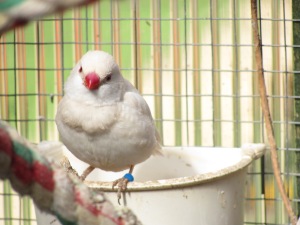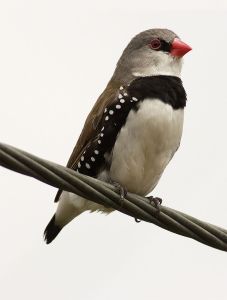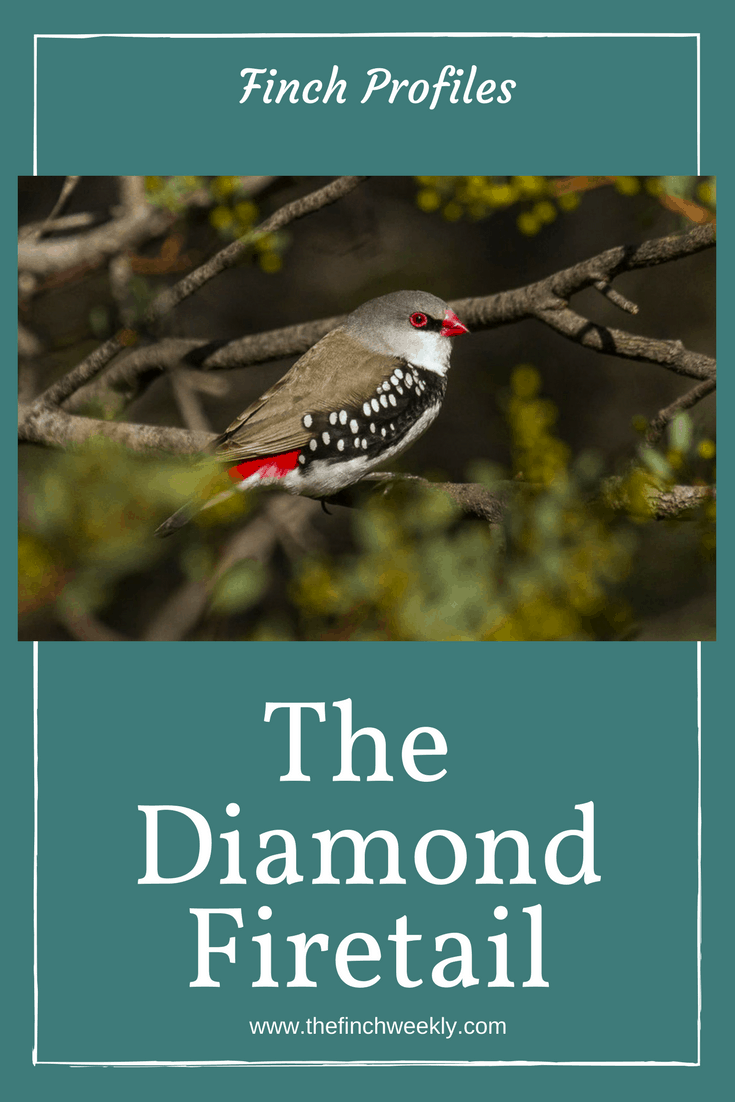The Diamond Firetail is an Australian finch that dares you to ignore it – with its bright red beak, sparkling black and while flanks and forthright personality, this isn’t a quiet little finch that disappears into the bushes. In fact, firetails have a reputation as being not the most sociable bird with other species and for this reason, some people hesitate to start keeping them. But are they really so anti-social?
Species basics
The Diamond Firetail (Stagonopleura guttata), also known as the Diamond Sparrow, are an Estrildid finch that is endemic to Australia and is found from the Eyre Peninsula of South Australia right through to the south-east of Queensland. There are a number of sites in three states that have been listed as important for the species conservation by BirdLife International, including the Greater Blue Mountains in New South Wales and the Patho Plains in Victoria. The bird has suffered from a loss of habitat across its native areas that has led to it being classified as ‘near threatened’ by the IUCN. Over grazing, weed invasion and the loss of plants that it relies on for food are also leading to major problems for the firetail.
One of the problems with the firetail is its distinctive looks – there is no real difference between male and female birds. Some say that the females have duller colours, smaller skulls and even a paler beak colour but none of these are conclusive. The bird has a silvery grey head colour with a white throat, bright red eye rings and maroon red beak. It has a black tail and a bright red rump while the flanks are black with white spots and the belly is also white.

There are a number of mutations that have surfaced in the captive breeding population. These include:
- Fawn – dark brown areas become a soft brown while black becomes dark brown (sex linked)
- Yellow – bird has an orange bill, rump and eye ring
- Silver – feathers are a silvery white with a light red rump
- Pied – random splashes of white among feathers that are otherwise coloured
Keeping Diamond Firetails
Firetails are often said to be best in good sized cages or flights as they can become lazy and prone to obesity if there isn’t much space to fly around. They are relatively hardy birds but should not be subjected to the worst of the weather without heating.
These birds form a strong pair bond and remain with each throughout their life. Outside the mating season, they will cluster in groups of 30 or more birds while during breeding, they use a colony system. They roost in a nest so should always have access to one, even outside breeding season as well as materials to line it with.
The firetails will enjoy a diet based around a good foreign finch mix along with seeding grasses and fresh greens such as kale, broccoli, lettuce and weeds such as dandelions and chickweed. They will enjoy millet spray as well as other treat seeds while sprouted seeds should be offered for their nutritional benefits. Some sources say they will benefit from live food such as mealworms or waxworms for their protein as well as to egg food. Mineral block, cuttlefish, grit or any similar product should be offered for both good eggs and strong bones.
Breeding season

Males court the females by dancing with a piece of grass in his beak, bobbing up and down and singing. He may approach the hen and use a begging posture, like a fledgling does and mating usually occurs in the nest. The birds will normally choose a nest that is fairly near to the ground with sense cover and will use a nesting box or build their own from grass, sisal, coconut fibre and other similar materials. Plant silks and feathers are added inside.
The typical clutch is 5-6 eggs and they are incubated for 13 days, usually after the 2nd egg is laid. The chicks remain in the nest for 21-26 days and then are weaned around a week later, at which time it can be advisable to move them to another enclosure. Firetails don’t appreciate nest inspections and can abandon eggs and young if disturbed.
Aggression
Diamond firetails are noted for their aggression but is this always the case? It seems that generally, they can live in a mixed aviary as long as there is plenty of room and they live with birds of a similar size, such as the grassfinches, zebra finches or cutthroat finches. Sometimes when coming to breeding condition, or when in the nest, they can be aggressive with other birds who seem to threaten their nest. They may also fight with others of their species or only one pair (the dominant one) will actually breed. The best way to know if a bird is settling into an environment is to watch them – if you see signs of aggression beyond chasing others away from the nest, then you may want to consider a change.

3
Hi there my name is Martin
I will like to buy a pair of diamonds firetail
Hi Martin, sorry this isn’t a sales forum but if you check out Facebook, there are lots of groups there where you can make contacts local to where you live and find the birds you want. Good luck!
Is the silver mutation a genetic disorder or are the bred like that? If bred what dominant white species finch do they pair with the Diamond Fire Tail?
Thank you for this article. It is the most informative I’ve read.